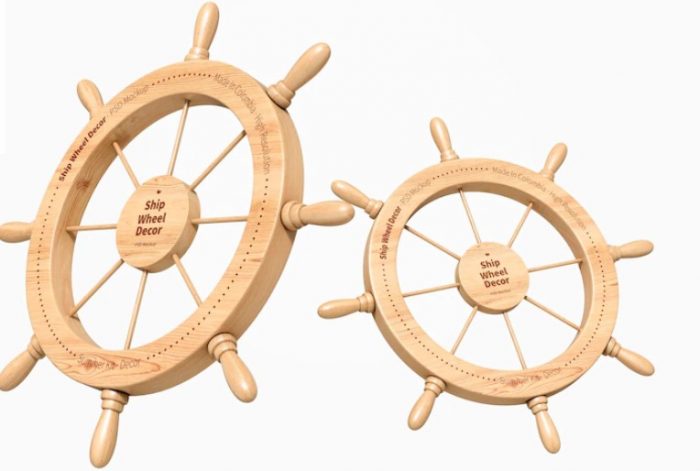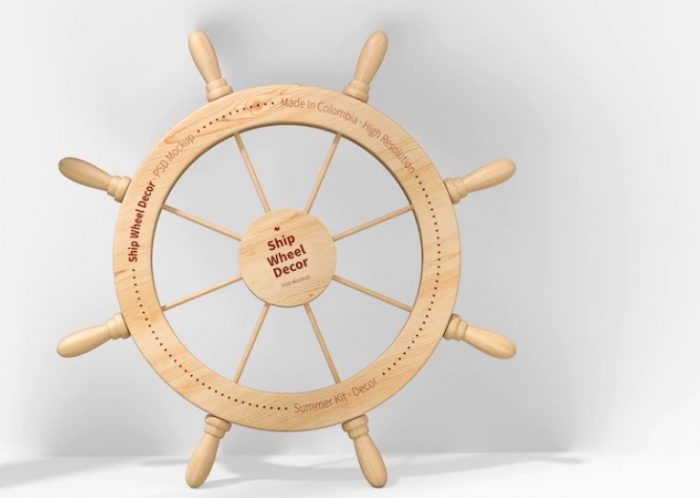A boat has only one wheel to control and direct it. A ship has 8 (eight) wheels. Land yachts have three wheels and ferry boats have 6 or more wheels. The smaller boats (sailboats/row boats) have no wheels at all.
Key Takeaways
- The ship wheels originally were placed in front of a cylindrical barrel and the large ships required the strength of two sailors to steer and control them
- Pollard’s system became standard use in 1775 due to its critical success
- Currently, there are two types of steering gear available: hydraulic system and electro-hydraulic system
- You should keep in mind that the control of the steering is done at the helm of the ship
- Sailboats that are more than 30 feet long are steered using a wheel
Boats & Wheels – The Table
| Boat Name | # No. of Wheels (or Other Mech.) |
|---|---|
| Trailer boats | 1 Wheel |
| Fiberglass | 1 Wheel |
| Bass Boats | 1 Wheel |
| Cruisers | Rudder |
| Catamarans | 1 Wheel |
| Dinghies | No Wheel |
| Game Boats | 1 Wheel |
| Ships | 2 or 6 or 8 Wheels |
| Inflatables | Blade |
| Sail Boats | Wind |
| Trawlers | Propellers or Sails |
The history of the steering wheel on the ship

The invention of the steering wheel was spearheaded by the navigation of ships in the world’s water for many centuries. Before the invention, the old whip staff technology was one that was being used for many centuries. British Royal Navy is credited with having implemented the steering wheel. However, there is not much evidence to support this speculation over who used the steering wheel first, which has led to more debate on the true origin of the wheel.
Even though the above story is considered “official,” many historians contest that the British army did not invent the wheel. Rather it’s common dock hands and artisans that are most likely the ones who invented it. The archives at Greenwich National Maritime Museum have a complete record of the invention of the steering wheel on the ship; you can get a full story from there.
Around 1703, it’s believed that’s when the first steering wheel was invented. The year is just guesswork, however, based on the ships that are seen using the early versions of the steering wheel of 1703, there is a possibility that it may have been invented many years back, and it just needed time to be accepted into the mainstream.
Early ship steering wheel
The early ship had its steering wheel located above the tiller’s end and at the back of the mizzen mast. It needed the helmsman to be more careful, as it was placed in a position that obstructed the captain’s view in hazardous ways. The ship wheels originally were placed in front of a cylindrical barrel. Due to their size, the large ships required the strength of two sailors to steer and control them in the right direction. Unfortunately, the space was small and couldn’t accommodate two sailors comfortably simultaneously to steer the ships, as they collided for the position at times. By 1740, some ships started to be made having two separate wheels to allow more sailors to steer the ship effectively at the same time.
The other common issue was that the slack given was uneven to the tiller ropes. As a result, the wheels could not be centered, which made the ship drift one way without an adequate amount of control. This led the rope to being too slack or too tight. After many years, an engineer named Pollard invented a new system to combat the growing problem. The system consisted of “sweeps and rowels” put to the test under Captain Bentinck in 1771. Pollard’s system became standard use in 1775 due to its critical success. Up to this date, there is no clarity on the evolution of the ship wheel during the 18th century.
How the wheel works

The rudder is the one that is turned to control the ship or boat. However, this cannot work without the help of a steering gear. The rudder cannot work without the steering gear to turn the boat when required. There are two types of steering gear that are present currently, namely:
- Hydraulic system
- Electro-hydraulic system
Some requirements have to be met for the steering gear to perform efficiently. These requirements include:
- The steering gear should manage to turn the ship from 35 degrees starboard to 35 degrees port and vice versa for maximum summer load line and continuously rated shaft rpm. This should happen when the vessel is tacking forward at a steady speed and a maximum of 28 seconds.
- When one of the power units is not working, the steering gear should manage to turn 15 degrees port to 15 degrees starboard and vice versa. The vessel moving at half its maximum speed of 7 knots at the summer load line should take 1 minute.
- The major power supplies and control units should at least be duplicated so that when one fails, the other can easily fit in the position of the other, and steering will continue without much trouble.
- For emergency power supply, the steering gear should have an additional power unit connected to the emergency power supply from the emergency generator. This should be able to turn the vessel 15 degrees port to degrees starboard and vice versa at a time of one minute when the vessel is moving at maximum speed.
Control of the steering is done at the helm of the ship. The force for turning is given from the wheel at the helm, and the force reaches the gearing system. The gearing system, in turn, genders a force at a certain scale that is transmitted to the rudder stock and turns the rudder.
The rudder is connected to a tiller or wheel that the captain will be controlling with. Most sailboats that are more than 30 feet long are steered using a wheel. Using the wheel is simple because if you want your vessel to turn left, you turn the wheel left and vice versa.
The tiller is a long stick that is made of wood used that is used with smaller sailboats. The main advantage of using a tiller is that it occupies less space; thus, it makes more sense to be on smaller vessels. It saves space for such boats. It is also connected directly to the rudder, so a small turn on it immediately affects the direction of the boat. Using it may be confusing at first because if you want the vessel to move left, you turn the tiller left and vice versa. Some sailors prefer the tiller because it has less friction. It connects them directly to the rudder and allows you to feel the flow of water below the boat. On the other hand, the wheel has a lot of mechanisms that are involved and cause a lot of friction.
Where to sit
When sailing a boat, you should know exactly where to sit to make you comfortable and look cool. Here are some tips.
- When you are steering a dinghy, you have to sit on the side where the winds mostly blow. This will help to stabilize it.
- Sit further forward of the tiller so that you can move freely. Since most tillers have an extension, you can sit further and still be able to steer comfortably. Plus, you will have a better view and look as cool as possible.
- When steering keelboats with a tiller, you should sit on either side of it. If the keelboat has a wheel, sit or stand on either side of the wheel, wherever you are most comfortable and where you have the perfect view.
- If your vessel has a blind spot, move around to look for any dangers you may be approaching. Your crew can also assist in this.
If you have a crew, they will mainly sit forward to the trimmer. Their main responsibility is trimming the sails. They sit mainly in the direction where the window blows, also called the windward side. This ensures that their role in keeping the vessel balanced is perfect. If the boat is large and has many crew members, you should divide the work.
Frequently asked questions (FAQs)
This section will discuss some of the questions that you may have asked yourself as you read this article. We have answered them to the most of our ability.
Do ships have a wheel?
Yes, ships have a wheel that controls their direction. The steering wheel is connected to the rudder, so if you turn the wheel right, the rudder will steer right, and the vessel will also turn right and vice versa.
Do boats have three wheels?
An amphibious boat, also called a duck boat, features three wheels. It is called a duck boat because of its shape. It is a vehicle that can move on both land and water.
How many spokes are in a ship’s wheel?
A ship’s wheel mostly has eight spokes, but some ships have as many as ten and as few as six. They are shaped like balusters and joined to a central wooden nave.
Where is the wheel of a ship located?
The ship’s wheel is located on the right-hand side of the boat, also called the starboard according to maritime terms.
Final Thoughts
In this article, we have seen that boats and ships have a wheel. The main wheel is the steering wheel, whose work is to control the whip and ensure it goes in the right direction. We have also looked at some of the basics of the wheel, including how it works, and by now, you have a rough idea of how this happens. If you are a captain, enjoy your time at the helm. If not, we hope that we have answered any questions you had before you read this and that you are fully satisfied.
References:
- https://www.quora.com/How-many-wheels-are-on-a-boat
- https://itboat.com/articles/2891-how-many-wheels-does-the-boat-have

Rockey is a kayaking enthusiast who has been kayaking with a local group for the last five years. He loves using kayaks while out on outings on the water or camping when the friends want to have a BBQ party somewhere on the bank of a local lake. More About James R Rockey at About Page Here: Authors
Based on his experiences with the different types of kayaks, he is sharing his opinion about kayaking tricks and required gears so that a beginner can get started right away.
Find his team on Twitter here. Happy reading!
